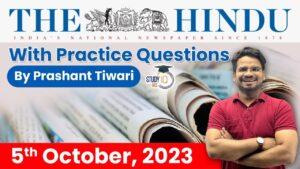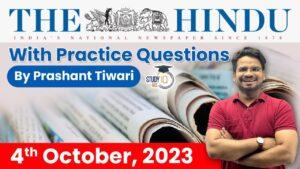The Hindu Newspaper Analysis for UPSC

The Hindu Newspaper Analysis 31 January 2023
- Though global uncertainties are rife and the world economy is slowing, the Survey exuded confidence that India’s GDP would grow 6.5% in 2023-24, after an estimated 7% this year, “supported by solid domestic demand and a pickup in capital investment”.
- “The Indian economy in 2022-23 has nearly ‘recouped’ what was lost, ‘renewed’ what had paused, and ‘re-energised’ what had slowed during the pandemic and since the conflict in Europe,” the Survey averred.
What is the Economic Survey?
- The Economic Survey of India is an annual document released by the Ministry of Finance.
- It contains the most authoritative and updated source of data on India’s economy.
- It is a report that the government presents on the state of the economy in the past one year, the key challenges it anticipates, and their possible solutions.
- It is prepared by the Economics Division of the Department of Economic Affairs (DEA) under the guidance of the Chief Economic Advisor.
- It is usually presented a day before the Union Budget is presented in the Parliament.
- The first Economic Survey in India was presented in the year 1950-51. Up to 1964, it was presented along with the Union Budget. From 1964 onwards, it has been delinked from the Budget.


- Three decades later, many developed economies, including America, Britain and Germany, are now reversing course to economic nationalism and increasing the role of government in their economy through industrial policy, ostensibly as a response to China’s economic might and a weaponisation of trade.
- This is a profound shift in economic thought — and perhaps the greatest symbolic victory for China’s economic model — that has forced the ‘Washington Consensus’ champions to back-pedal.
- In this context, what should India’s economic strategy be? Should India too revert to increased state control of the economy through an active industrial policy?
- Surveys of the previous years had put out various ideas and issues such as universal basic income, economic divergence among States, steps to improve property tax revenues using satellite technology, new ways to calculate inflation using the Indian thali, estimating internal migration of people and so on.
- Unlike previous years, this year’s Survey has only one volume and also a separate ‘Highlights’ volume that lays out the key messages creatively and simplistically for a larger audience.
- Like the government of the day, the Economic Survey also suffers from the ‘take credit for the rains but blame nature for the drought’

- Apart from the external pressure that is pushing India more and more into the so-called carbon limiting renewable energy path, the Prime Minister’s own enthusiasm and support and a simple understanding that solar energy is a free gift from the sun have made identifying what is good for the country difficult.
- The first is the wrong comparison of solar power with coal electricity at the load centre, instead of at the pithed, which costs about half that of the load centre. According to the Central Electricity Authority, which was once the final arbiter in electricity matters, moving electricity through high voltage wires is cheaper than moving coal — and that is the reason for starting the National Thermal Power Corporation Limited (now NTPC Limited) during K.C. Pant’s time.
- The second flaw is not comparing like with like. Solar electricity is intermittent and coal electricity is continuous. So, you have to add the cost of storage by battery.
- solar energy is made financially viable by misguiding the people by leaving out storage battery cost; handicapping it with subsidies and concessions that are front loaded by the government, and forcing it on the industry and hapless discoms through state policy.
- There seems to be competition, egged on by the West, between India and China, as to who does more renewable energy. We can do more renewable energy in large hydro, which is both low carbon and least cost. India has utilised only about 15% of its hydro potential whereas the U.S. and Europe have utilised 90% and 98% of their potential, respectively.
- The extent of utilisation of hydro potential seems to be an index of civilisational development and evolution. While China relies on renewable energy, it banks more on coal and hydro. The Three Gorges project on the Yangtze is the world’s biggest hydro electric project. In India, powerful environmentalists stop large hydro projects in their tracks. One major reason for the sickness in the power sector is due to the focus on renewable energy in a big way.

- Myanmar today remains pessimistic about its future. Exactly two years ago, the military staged yet another coup, snatching power from the elected leaders. It derailed the limited democracy of the previous decade, violating the 2008 constitution which the generals had given to the people.
- Many Burmese people tend to place their hopes on some miraculous assistance from the outside world. Unfortunately, the international community stands fractured while coping with the crisis in Myanmar.
- The UN is supportive of ASEAN, ever keen to play a mediator’s role in Myanmar. But the Myanmar government refuses to cooperate with ASEAN.
- China and Russia are busy forging close cooperation with the government. China has extensive interests ranging from the strategic to economic domains.
- As the world’s largest democracy, India desires a stable and prosperous Myanmar where democracy flourishes. But realpolitik comes in the way. New Delhi follows the policy of dealing with the government of the day.

- The Data Point published on January 23 showed that the math skills of rural schoolchildren in the southern and western States were impacted most due to COVID-19. However, further reading of the Annual Status of Education Report (2022), based on which the story was written, shows that the reading abilities of rural schoolchildren were impacted even more than math skills.
- In 15 of the 27 States for which relevant data were available, the share of students in Class VIII who could carry out division problems decreased in 2022 compared to 2018. In 19 States, the share of them who could read Standard II-level text decreased in 2022 compared to 2018. Thus, the adverse impact of COVID-19 on reading abilities was seen in more States.

- Almost half of all health spending in India is still paid by patients themselves directly at the point of treatment, though out-of-pocket expenditure has dropped as the government’s share of spending on health went up significantly after 2013-14, the Economic Survey 2022-23 says.
- The share of government in the total health expenditure was just 28.6% in the financial year 2013-14, but rose to 40.6% by 2018-19, the latest year for which data are available. There was a concomitant decline in out-of-pocket expenditure from 64.2% in 2013-14 to 48.2% in 2018-19.
- Out-of-pocket expenditure is the money paid by households at the point of receiving health care. This occurs when services are neither provided free of cost through a government health facility, nor is the individual covered under any public or private insurance or social protection scheme.
- PM-JAY is the world’s largest health insurance/ assurance scheme fully financed by the government.
- Launched in February 2018, it offers a sum insured of Rs.5 lakh per family for secondary care (which doesn’t involve a super specialist) as well as tertiary care (which involves a super specialist).
- Under PMJAY, cashless and paperless access to services are provided to the beneficiaries at the point of service, that is, hospital.
- Health Benefit Packages covers surgery, medical and day care treatments, cost of medicines and diagnostics.

- Identifying the shipbuilding industry as a strategically important industry for its role in energy security, national defence, and the development of the heavy engineering industry, the Economic Survey, 2022-23 noted that it has the potential to increase the contribution of the industry and the services sector to the national GDP.
- With its various direct and indirect linkages with most other leading industries, and its huge dependence on the infrastructure and services sectors of the economy, the shipbuilding industry has the potential to strengthen the mission of an ‘Aatmanirbhar Bharat’, the survey said.
- For instance, the recently commissioned aircraft carrier INS Vikrant alone engaged approximately 500 MSMEs, 12,000 employees from ancillary industries, and 2,000 shipyard employees, it noted.
- In its simplest terms, the employment multiplier measures the amount of direct, indirect and induced jobs created (or lost) in the area.

- For India to meet its international “obligations” on curtailing greenhouse gas emissions, it must have access to “on-time” climate finance, technology, and access to critical minerals. Advanced economies ought to set examples of policy and “behavioural changes” that work in their countries and only then could they be emulated in developing countries, the Economic Survey said on Tuesday in a dedicated chapter on climate change.
- The perspective aligns with India’s policies on addressing climate change, namely, climate justice and Mission LiFE (Lifestyle for Environment), a campaign led by the Prime Minister and now adopted across government.

- The budgetary allocation for education as a percentage of total expenditure has dropped over the past seven years, from 10.4% to 9.5%, the Economic Survey, 2022-23 says.
- While the expenditure on social services increased from ₹9,15,500 crore to ₹21,32,059 crore, the share of education within this umbrella category shrank from 42.8% to 35.5% between the financial years 2015-16 and 2022-23, according to budgetary documents.
- Part of this could be attributed to the faster growth in spending on health and other measures due to the COVID-19 pandemic.
- Though school dropout rates have improved since 2013-14, there has been some reversal of gains since COVID-19, especially in the younger classes.
- In 2019-20, the total dropout rate in primary school was 1.5%, which fell to 0.8% in 2020-21, but rose back to 1.5% in 2021-22.
- However, this is significantly better than the 4.7% dropout rate in 2013-14.
- The total enrolment in higher education has increased to nearly 4.1 crore in financial year 2020-21 from 3.9 crore in 2019-20. Since 2014-15, there has been an increase of around 72 lakh or 21% in enrolment, while distance education has also grown at a similar rate of 20%. In 2021-22, distance education saw a 7% growth over the previous year, with 45.7 lakh enrolling.

- India’s 8 core sectors’ output growth hit a 3-month high of 7.4% in December, from a revised uptick of 5.7% in November, with all sectors save crude oil reporting a rise.
- Overall, the eight core sectors have now registered an 8% growth in the first nine months of 2022-23, compared with 12.6% in the same period of 2021-22. Coal, cement, electricity and fertilizers registered double-digit or close to 10% growth through the year, while crude oil output was down 1.3%.
- In December 2022, coal production and electricity generation led the way, rising 11.5% and 10%, respectively, followed by steel (9.2%), cement (9.1%) and fertilizers (7.3%). Refinery products grew 3.7% after two months of contraction, while natural gas output also recovered after a five-month shrinkage streak to grow 2.6%.
- Crude oil output contracted for the seventh straight month, by 1.2%.
- These are the most important sectors of the economy and constitute 40.27% of the weight of items included in the Index of Industrial Production (IIP).
- The Index of eight core industries (ICI) is prepared every month by the Office of the Economic Adviser (OEA), the Department for Promotion of Industry and Internal Trade (DPIIT), and the Ministry of Commerce & Industry.
- Coal – Coal production, excluding Coking coal.
- Electricity – Electricity generation of thermal, nuclear, hydro, imports from Bhutan.
- Crude Oil – Total crude oil production.
- Cement – Production in large plants and mini plants.
- Natural Gas – Total production of natural gas.
- Steel – Production of alloy and non-alloy steel only.
- Refinery Products – Total refinery production.
- Fertilizer – Urea, ammonium sulfate, calcium ammonium nitrate, complex grade fertilizer, and single superphosphate, among others.
- The Eight Core Industries in decreasing order of their weightage are Refinery Products> Electricity> Steel> Coal> Crude Oil> Natural Gas> Cement> Fertilizers.
Q) Consider the following statements about the Indus Waters Treaty (IWT).
- It is a water-distribution treaty between India and Pakistan, brokered by the United States of America.
- The treaty not allows India to use the western river waters for limited irrigation use and unlimited non-consumptive use for such applications as power generation.
Which of the above statements is/are Incorrect?
- 1 only
- 2 only
- Both 1 and 2
- Neither 1 nor 2
सिंधु जल संधि (IWT) के बारे में निम्नलिखित कथनों पर विचार करें।
- यह भारत और पाकिस्तान के बीच एक जल-वितरण संधि है, जिसमें संयुक्त राज्य अमेरिका की मध्यस्थता है।
- संधि भारत को सीमित सिंचाई उपयोग और बिजली उत्पादन जैसे अनुप्रयोगों के लिए असीमित गैर-उपभोग उपयोग के लिए पश्चिमी नदी के पानी का उपयोग करने की अनुमति नहीं देती है।
उपरोक्त में से कौन सा/से कथन गलत है/हैं?
- केवल 1
- केवल 2
- 1 और 2 दोनों
- न तो 1 और न ही 2
Explanation:
- IWT is a water-distribution treaty between India and Pakistan, brokered by the World Bank (WB), to use the water available in the Indus River and its tributaries. It is often cited as an example of the possibilities of peaceful coexistence despite the troubled relationship.
- It was signed in Karachi in 1960 by then-Indian PM Jawaharlal Nehru and then-Pakistani president Ayub Khan.
- The Treaty gives control over the waters of the three “eastern rivers” – the Beas, Ravi and Sutlej (BRS)- to India, while control over the waters of the three “western rivers” – the Indus, Chenab and Jhelum -has been given to Pakistan.
- India has about 20% of the total water carried by the Indus system while Pakistan has 80%.
- The treaty allows India to use the western river waters for limited irrigation use and unlimited non-consumptive use for such applications as power generation.
Q) What is an inclusive circular economy?
- A model of production and consumption in which resources are kept in use for as long as possible, minimizing waste and pollution.
- A system in which waste and resources are repurposed, reducing the need for new production, but not considering social equity.
- A model of production and consumption in which waste and resources are repurposed, reducing the need for new production, while considering social equity and environmental sustainability.
- A system in which waste and resources are kept in use for as long as possible, maximizing waste and pollution.
एक समावेशी परिपत्र अर्थव्यवस्था क्या है?
- उत्पादन और खपत का एक मॉडल जिसमें संसाधनों को यथासंभव लंबे समय तक उपयोग में रखा जाता है, अपशिष्ट और प्रदूषण को कम करता है।
- एक प्रणाली जिसमें अपशिष्ट और संसाधनों का पुनरुत्पादन किया जाता है, नए उत्पादन की आवश्यकता को कम करता है, लेकिन सामाजिक इक्विटी पर विचार नहीं करता है।
- उत्पादन और खपत का एक मॉडल जिसमें सामाजिक इक्विटी और पर्यावरणीय स्थिरता पर विचार करते हुए, नए उत्पादन की आवश्यकता को कम करते हुए अपशिष्ट और संसाधनों का पुन: उपयोग किया जाता है।
- एक प्रणाली जिसमें अपशिष्ट और संसाधनों को यथासंभव लंबे समय तक उपयोग में रखा जाता है, अपशिष्ट और प्रदूषण को अधिकतम करता है।
Explanation:
- The inclusive circular economy is an approach to the circular economy that incorporates social equity and environmental sustainability into the system. This means that the circular economy is designed to consider the needs of all stakeholders, including workers, communities, and the environment, as well as to reduce waste and pollution and promote sustainable production and consumption.
Q) World Economic Situation and Prospects report is published by
- IMF
- UNDP
- WTO
- None of the above
वर्ल्ड इकोनॉमिक सिचुएशन एंड प्रॉस्पेक्ट्स रिपोर्ट किसके द्वारा प्रकाशित की जाती है?
- आईएमएफ
- यूएनडीपी
- विश्व व्यापार संगठन
- उपर्युक्त में से कोई नहीं
Explanation:
- UNDESA (in partnership with UNCTAD and five regional UN commissions) have produced this report.
Q) Which of the following indicators impact population growth?
- Life expectancy
- Crude Death Rate
- Total Fertility Rate
Select the correct answer code:
- 1, 2
- 1, 3
- 2, 3
- 1, 2, 3
निम्नलिखित में से कौन सा संकेतक जनसंख्या वृद्धि को प्रभावित करता है?
- जीवन प्रत्याशा
- अशोधित मृत्यु दर
- कुल प्रजनन दर
सही उत्तर कूट का चयन करें:
- 1, 2
- 1, 3
- 2, 3
- 1, 2, 3
- Key indicators impacting population growth, such as life expectancy (the number of years a person is expected to live on average), the Crude Death Rate (the number of deaths in a population per 1,000 people) and Total Fertility Rate or TFR (the number of children a woman, on average, is expected to bear in her lifetime).
Mains Practice Question:
Q) “Investment in infrastructure is essential for more rapid and inclusive economic growth.” Discuss in the light of India’s experience. (250 words) (2021)
“अधिक तीव्र और समावेशी आर्थिक विकास के लिए बुनियादी ढांचे में निवेश आवश्यक है।” भारत के अनुभव के प्रकाश में चर्चा कीजिए। (250 शब्द) (2021)


 The Hindu Newspaper Analysis 6 October 2...
The Hindu Newspaper Analysis 6 October 2...
 The Hindu Newspaper Analysis 5 October 2...
The Hindu Newspaper Analysis 5 October 2...
 The Hindu Newspaper Analysis 4 October 2...
The Hindu Newspaper Analysis 4 October 2...

















